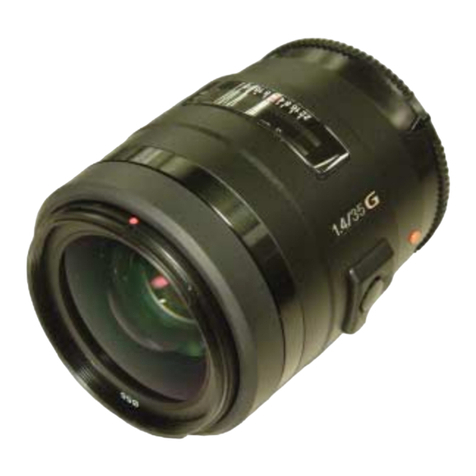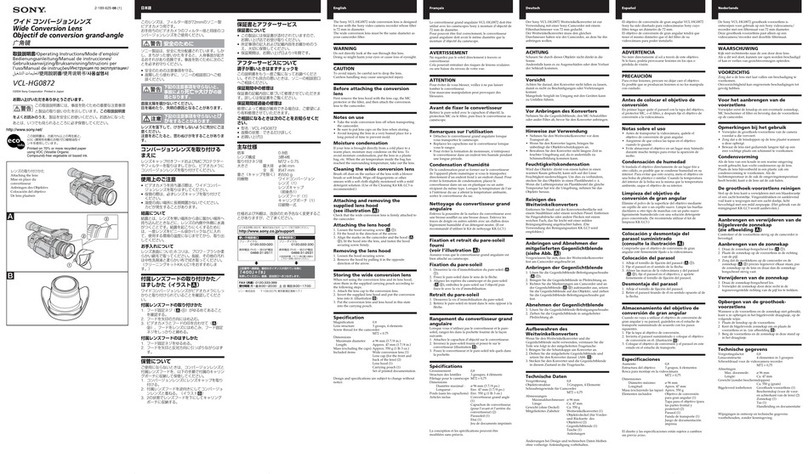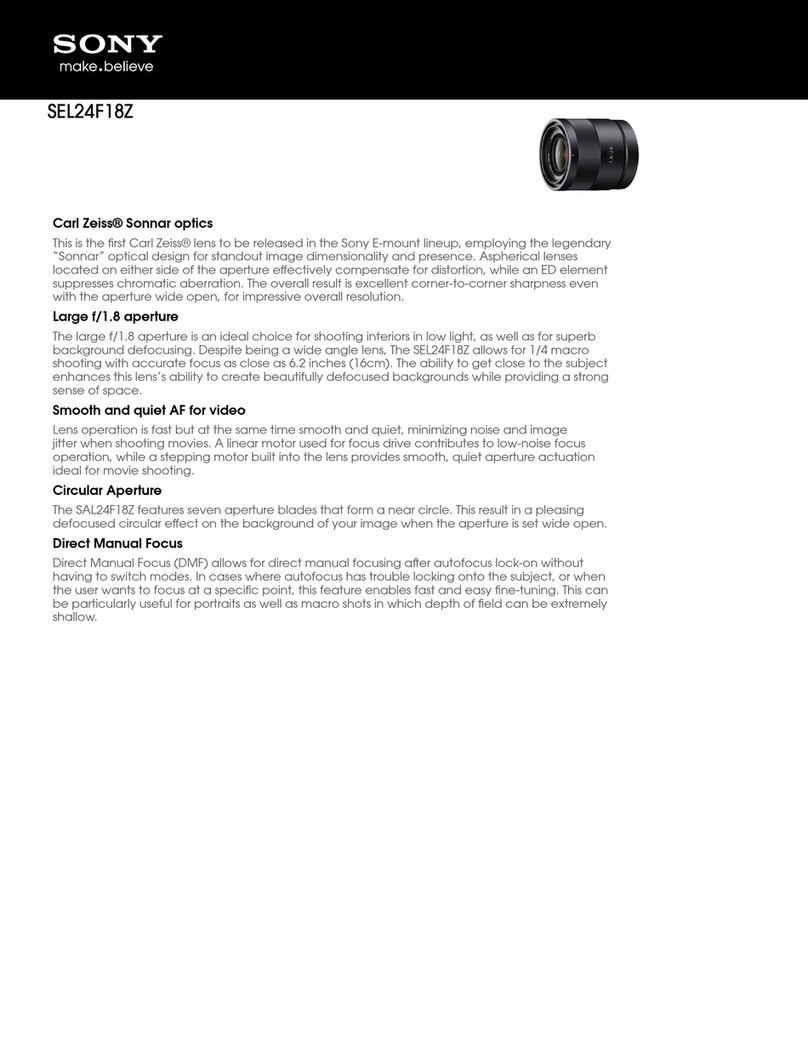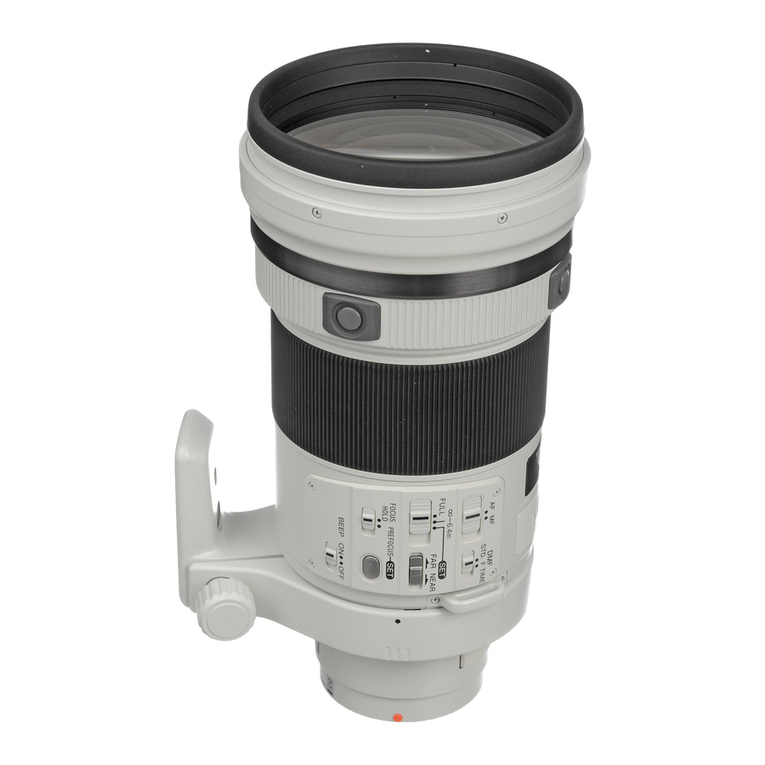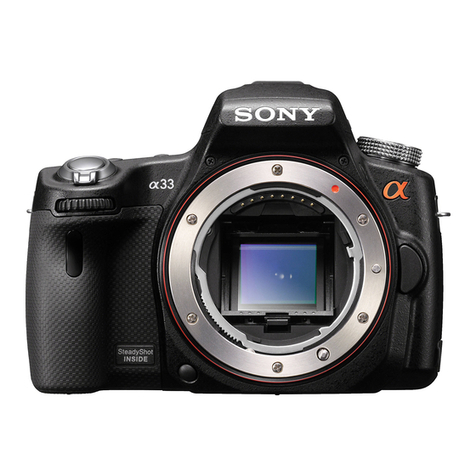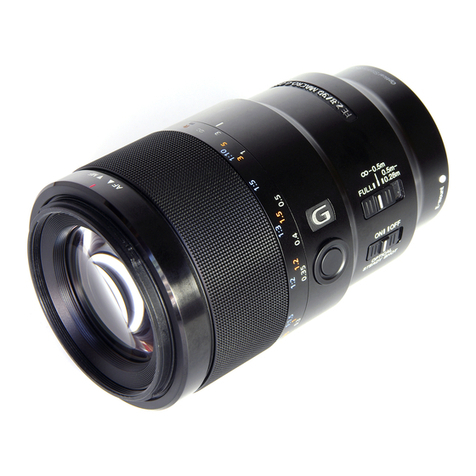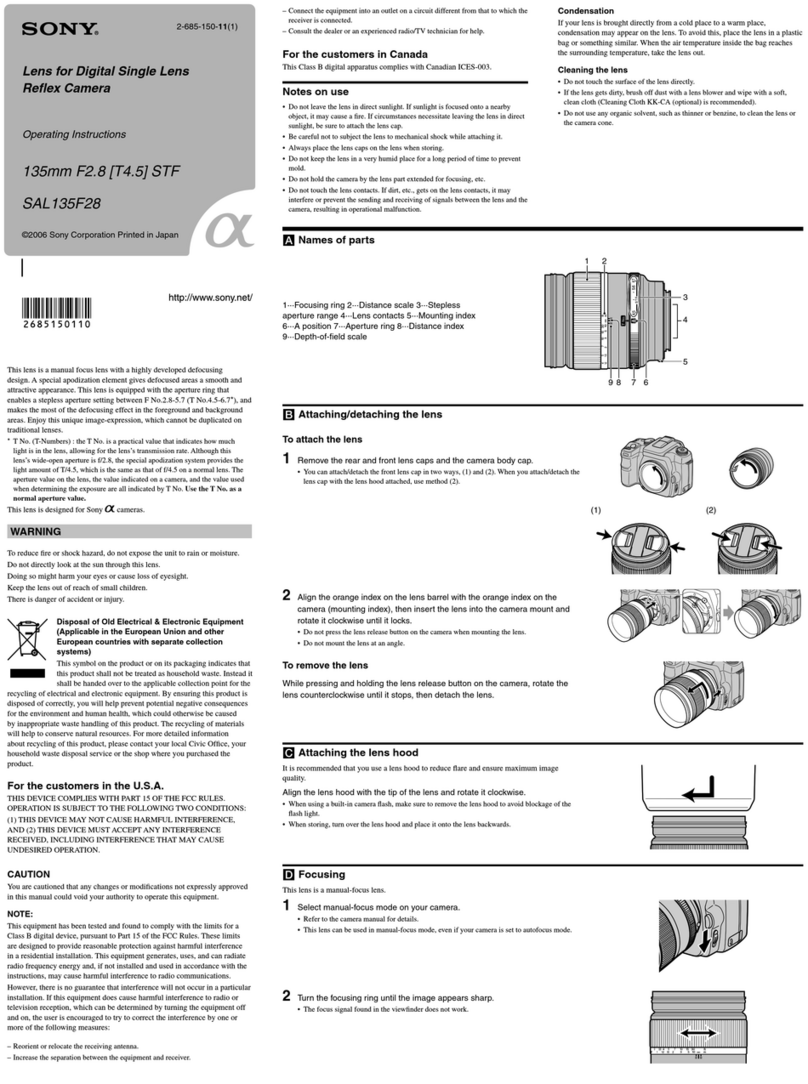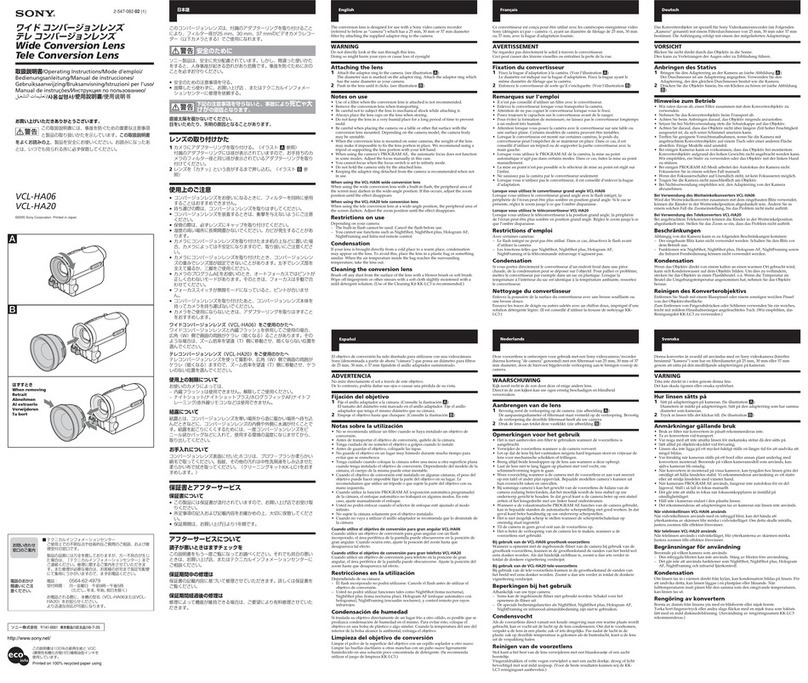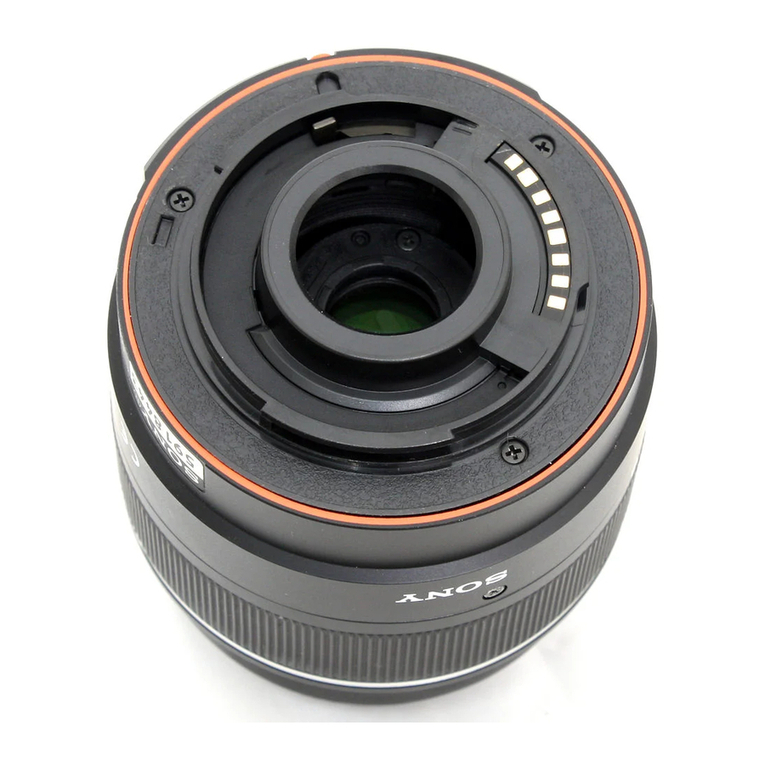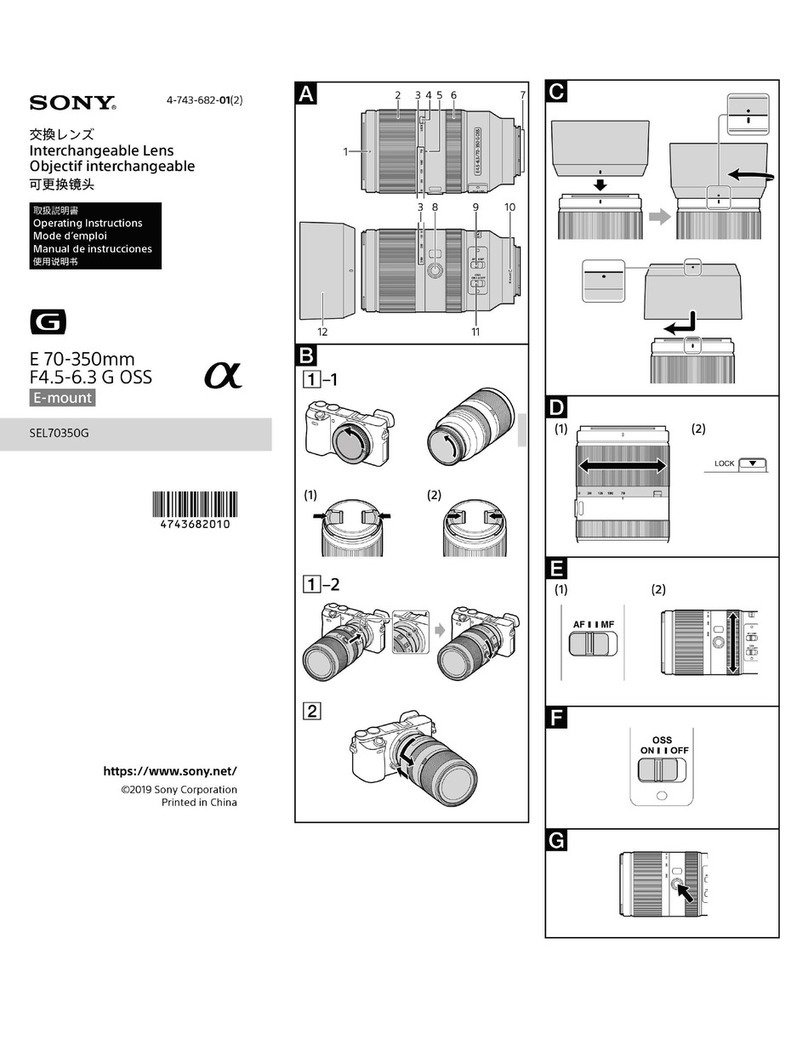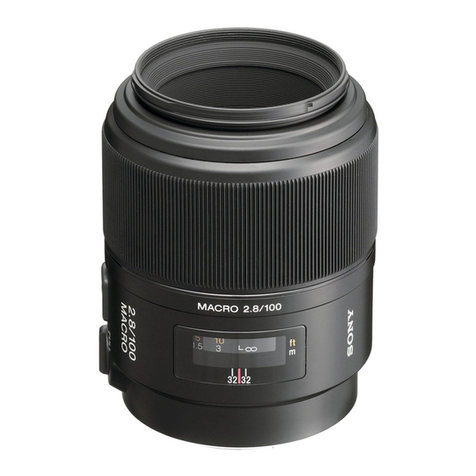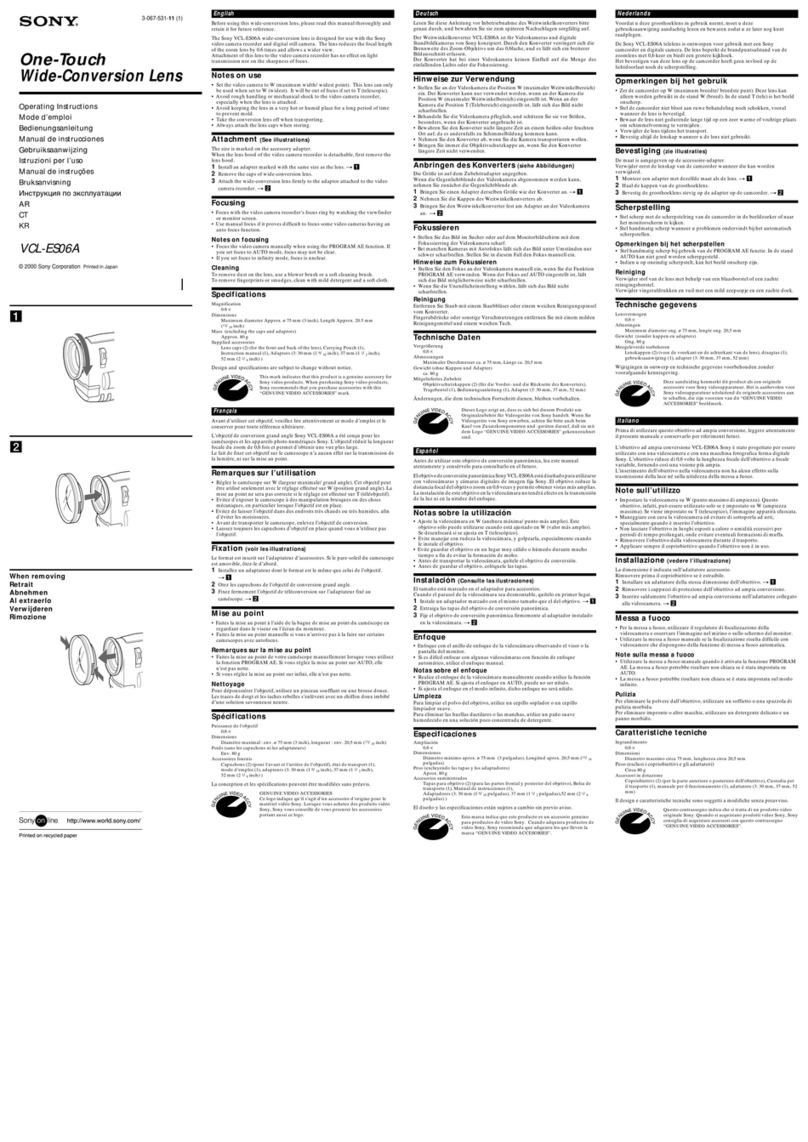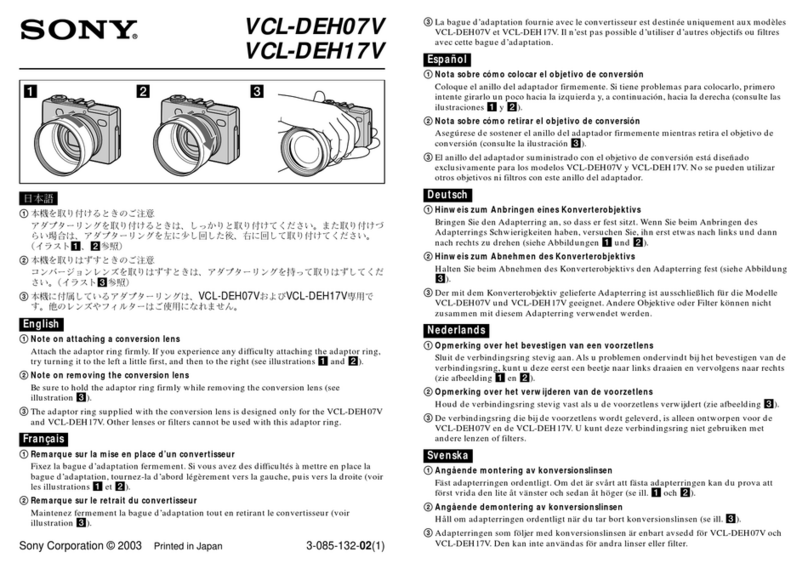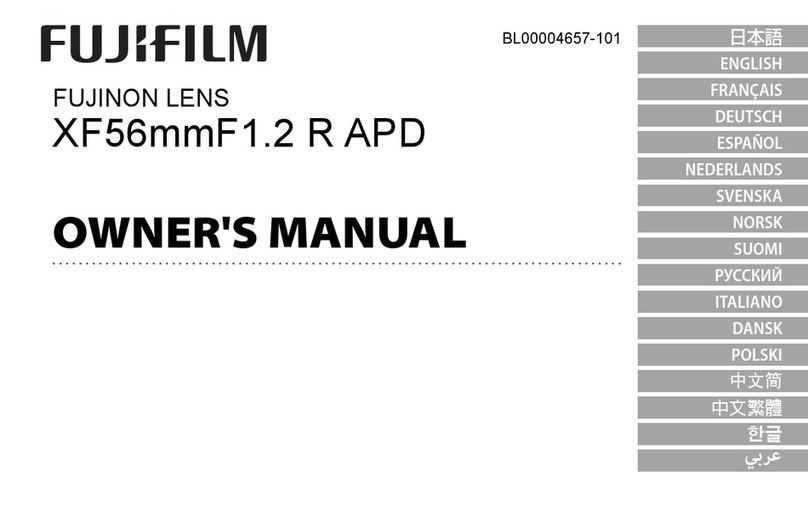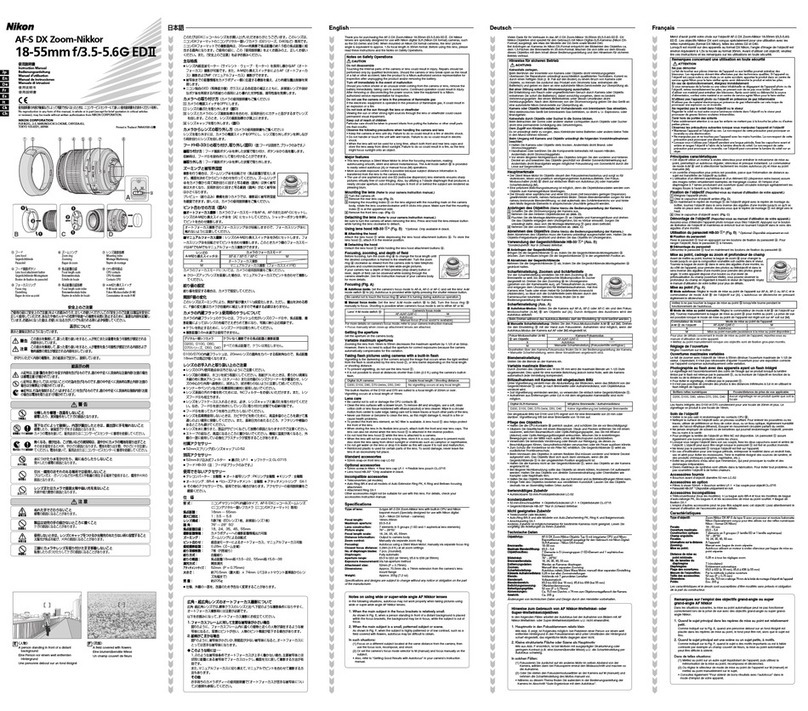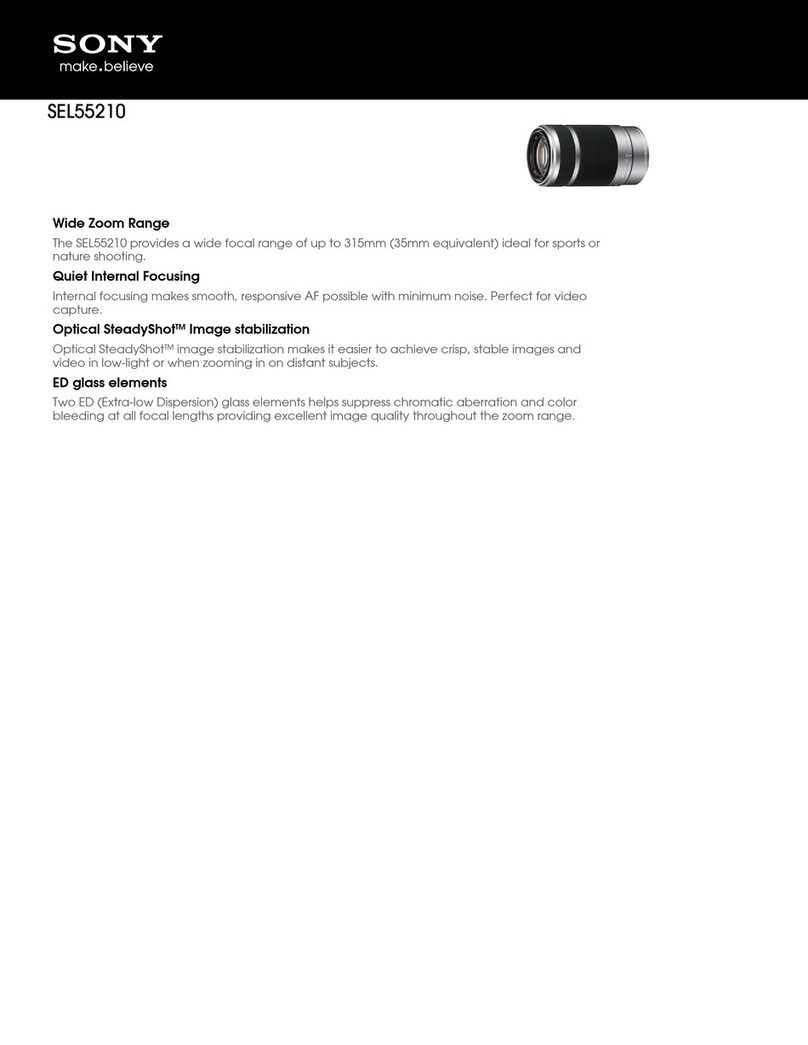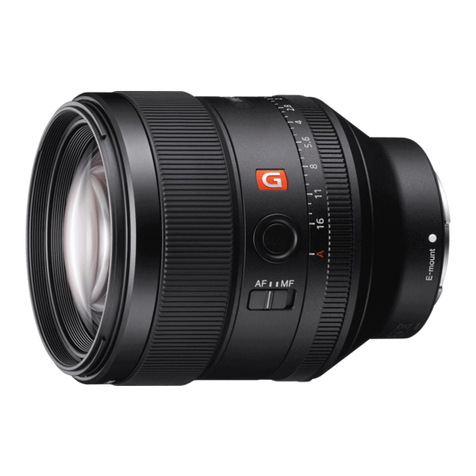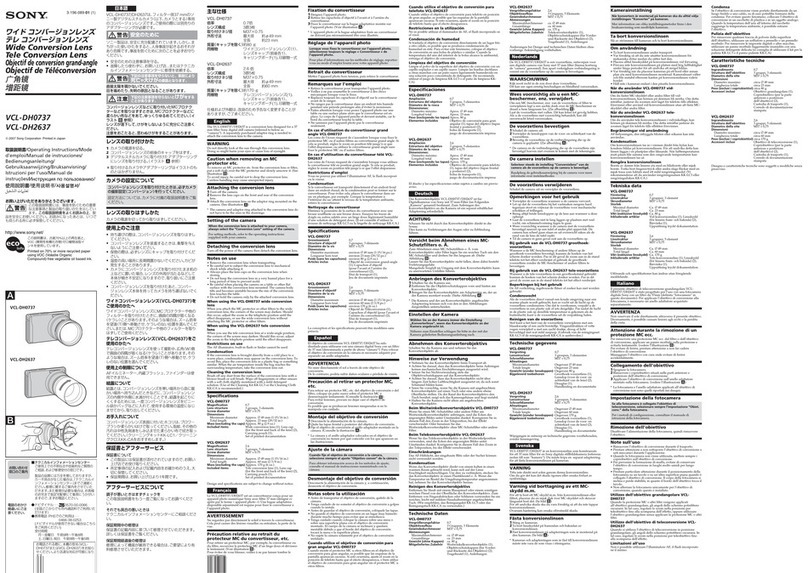
–1
(1) (2)
–2
(1) (2)
(3) (4)
(1) (2)
(1) (2)
Mise au point
Commutation AF (mise au point automatique) et MF (mise
au point manuelle)
Il est possible de régler le mode de mise au point sur AF ou MF sur l’objectif.
Pour effectuer des prises de vue en mode AF, l’appareil photo et l’objectif
doivent tous deux être réglés sur AF. Pour effectuer des prises de vue en
mode MF, l’appareil photo ou l’objectif doit être réglé sur MF.
Réglage du mode de mise au point sur l’objectif
Réglez le commutateur du mode de mise au point sur le mode
adapté, AF ou MF (1).
En mode MF, tournez la bague de mise au point pour régler la mise au point (2)
tout en regardant dans le viseur, etc.
Utilisation d’un appareil photo doté de la touche de
commande AF/MF
Appuyez sur la touche de commande AF/MF pour passer de AF à MF lorsque
l’appareil photo et l’objectif sont réglés sur AF.
Appuyez sur la touche de commande AF/MF pour passer de MF à AF lorsque
l’appareil photo est réglé sur MF et l’objectif sur AF.
Mise au point manuelle directe (DMF)
Même lorsque le mode AF est sélectionné, le réglage passe automatiquement
sur MF si vous tournez la bague de mise au point tout en enfonçant le
déclencheur à mi-course. Cela fournit un réglage précis et rapide de la mise
au point (DMF). Sélectionnez le mode approprié à la DMF parmi les modes
suivants. Réglez le commutateur du mode DMF selon vos préférences.
DMF standard (STD.)
Tournez la bague de mise au point pour régler le mode DMF correctement
lorsque la mise au point est verrouillée sur AF-A (mise au point auto
automatique) ou AF-S (mise au point automatique unique). Ce mode est
recommandé pour des sujets normaux.
La mise au point manuelle directe (DMF) n’est pas disponible en mode AF-C
(mise au point automatique continue), lorsque l’image n’est pas nette ou en
avance continue en mode AF-A, une fois la seconde mise au point confirmée.
DMF permanente (F TIME)
En mode AF (AF-A/S/C), tournez la bague de mise au point tout en
enfonçant le déclencheur à mi-course pour régler le mode DMF adapté. Ce
mode est utile pour photographier un sujet en mouvement.
Prise de vue à l’infini en mode MF (mise au point manuelle)
Le mécanisme de mise au point tourne légèrement au-delà de l’infini
afin d’obtenir une mise au point précise à diverses températures de
fonctionnement. Vérifiez toujours la netteté de l’image en regardant dans le
viseur, etc., notamment lorsque le réglage de l’objectif est proche de l’infini.
Utilisation des touches de désactivation de la
mise au point
Cet objectif comporte 3 touches de désactivation de la mise au point.
En mode AF, appuyez sur la touche de désactivation de la mise au point pour
annuler la fonction AF. La mise au point est fixée et vous pouvez relâcher le
déclencheur à la mise au point définie. Relâchez la touche de désactivation de
la mise au point tout en enfonçant le déclencheur à mi-course pour activer à
nouveau le mode AF.
Le fonctionnement de la touche de désactivation de la mise au point peut être
modifié sur les appareils photos dotés de la fonction de personnalisation. Pour
plus de détails, consultez les manuels de l’appareil photo.
Modification de la plage de mise au point (plage
AF)
Le limiteur de plage de mise au point vous permet de réduire le temps de
mise au point automatique. Ce mode est utile lorsque la distance du sujet est
précise. Vous pouvez également régler la plage de mise au point selon votre
convenance et la sélectionner.
Réglez le limiteur de plage de mise au point pour sélectionner la
plage de mise au point.
FULL : AF est réglé sur la distance de mise au point minimale à l’infini.
- 3m : AF est réglé sur 3 m (9,8 pieds) à l’infini.
Tableau de profondeur de champ
Les ensembles de trois chiffres, situés en haut, au milieu et en bas,
représentent, respectivement, des distances focales de 70 mm, 105 mm et
200 mm, en mètres.
Le tableau des profondeurs de champ concerne les appareils photos au
format 35 mm. La profondeur de champ est réduite lorsque vous utilisez des
appareils photos numériques à objectifs interchangeables avec un capteur
d’image au format APS-C.
Spécifications
Nom (désignation du modèle) 70-200mm F2.8 G (SAL70200G)
Longueur focale équivalente au format
35 mm*1(mm)
105-300
Eléments/Groupes d’objectifs 16-19
Angle de vue 1*234°-12°30’
Angle de vue 2*223°-8°
Mise au point minimale*3(m (pieds)) 1,2 (4,0)
Grossissement maximal (×) 0,21
Valeur f minimale f/32
Diamètre du filtre (mm) 77
Dimensions (diamètre maximum ×
hauteur) (mm (po))
Environ 87×196,5 (3 1/2×7 3/4)
Poids (g (on.))
(sauf cadre de montage du trépied)
Environ 1 340 (47 1/4)
*1
Les valeurs pour une longueur focale équivalente au format 35 mm sont basées sur
des Appareils photos numériques à objectifs interchangeables équipés d’un capteur
d’image au format APS-C.
*2La valeur pour un angle de vue 1 est basée sur des appareils photos au
format 35 mm et celle de l’angle de vue 2 est basée sur des Appareils photos
numériques à objectifs interchangeables équipés d’un capteur d’image au
format APS-C.
*3La mise au point minimale est la distance entre le capteur d’image et le sujet.
Cet objectif dispose d’un encodeur de distance. L’encodeur de distance permet
d’effectuer des mesures plus précises (ADI) à l’aide d’un flash.
Selon le mécanisme d’objectif, la longueur focale peut varier en fonction de la
distance de prise de vue. La longueur focale suppose que l’objectif est réglé sur
l’infini.
Articles inclus : Objectif (1), Capuchon d’objectif avant (1), Capuchon
d’objectif arrière (1), Pare-soleil (1), Étui pour objectif (1), Jeu de documents
imprimés
La conception et les spécifications peuvent être modifiées sans préavis.
et sont des marques commerciales de Sony Corporation.
Les noms des compagnies et les noms des produits sont des marques de
fabrique ou des marques déposées de ces compagnies.
Français
Des informations relatives à l’utilisation de chaque objectif sont
disponibles dans ce manuel. La section « Précautions avant toute
utilisation », qui fait l’objet d’un document séparé, contient des
précautions relatives aux objectifs, telles que des remarques sur leur
utilisation. Veuillez lire attentivement ces deux documents avant
d’utiliser l’objectif.
Ce manuel est destiné à être utilisé pour plusieurs objectifs différents.
Cet objectif est conçu pour les montures A, à utiliser sur les appareils photo
αSony.
Remarques sur l’utilisation
Lorsque cet objectif est utilisé avec un appareil photo à monture E, rattachez
un adaptateur pour monture d’objectif vendu séparément. Ne rattachez pas
directement l’objectif à l’appareil photo à monture E sinon l’objectif et l’appareil
pourraient être endommagés.
Tenez fermement à la fois l’appareil photo et l’objectif lorsque vous transportez
l’appareil photo avec l’objectif fixé.
Précaution concernant l’utilisation du flash
Lorsque vous utilisez le flash intégré à l’appareil photo, n’oubliez pas de
retirer le pare-soleil. Dans le cas de certaines combinaisons objectif/flash,
l’objectif peut partiellement bloquer la lumière du flash, ce qui génère une
ombre en bas de l’image.
Vignetage
Lorsque vous utilisez l’objectif, les coins de l’écran peuvent s’assombrir par
rapport au centre. Pour réduire ce phénomène (appelé vignetage), l’ouverture
doit être réglée à une valeur comprise entre 1 et 2 par rapport à la position de
fermeture complète.
Noms des pièces
1…Repère du pare-soleil 2···Bague de mise au point 3···Bague du zoom
4···Echelle de la longueur focale 5···Repère de la longueur focale 6···Repère de
montage du cadre (rouge) 7···Repère de l’objectif (gris) 8···Repère du cadre
(gris) 9···Contacts de l’objectif 10···Cadre 11···Index de distance 12···Echelle
de mise au point 13···Commutateur de mise au point 14···Repère de montage
de l’objectif 15···Commutateur du mode DMF 16···Limiteur de plage de mise
au point 17···Bouton de verrouillage du cadre 18···Touche de désactivation de
la mise au point
Fixation/retrait de l’objectif
Fixation de l’objectif (Voir l’illustration –.)
1Retirez les capuchons d’objectif situés à l’avant et l’arrière, ainsi
que le capuchon de l’appareil photo.
Vous pouvez fixer/détacher le capuchon avant de l’objectif de deux façons,
(1) et (2). Lorsque vous fixez/détachez le capuchon d’objectif alors que le
pare-soleil est en place, utilisez la méthode (2).
2Alignez le repère orange situé sur la monture de l’objectif sur
le repère orange de l’appareil photo (repère de montage), puis
insérez l’objectif dans la monture de l’appareil photo et tournez-le
dans le sens horaire jusqu’à ce qu’il se bloque.
N’appuyez pas sur la touche de déblocage de l’objectif de l’appareil photo
lorsque vous fixez l’objectif.
Ne fixez pas l’objectif de travers.
Retrait de l’objectif (Voir l’illustration –.)
Tout en maintenant la touche de déblocage de l’objectif sur l’appareil
photo enfoncée, tournez l’objectif dans le sens anti-horaire jusqu’à la
butée, puis détachez l’objectif.
Utilisation du trépied
Lors de l’utilisation d’un trépied, fixez-le sur le cadre de montage de l’objectif
et non pas sur le logement du trépied de l’appareil photo.
Modification de la position verticale/horizontale
Desserrez la touche de verrouillage du cadre sur le cadre de montage du trépied
(1) puis orientez l’appareil photo dans le sens de votre choix. Lorsque vous
utilisez un trépied, vous pouvez rapidement passer d’une position à l’autre tout
maintenant la stabilité de l’appareil photo.
Les repères gris (repères du cadre) sont indiqués à intervalles de 90 ° sur le cadre
de montage du trépied. Alignez le repère gris situé sur le cadre de montage du
trépied sur le repère gris (repère du cadre) de l’objectif pour régler précisément
l’orientation de l’appareil photo (2).
Après avoir réglé l’orientation de l’appareil photo, serrez fermement le bouton
de verrouillage du cadre.
Détachement du cadre de montage du trépied de
l’objectif
Lors de l’utilisation d’un trépied, il est possible de détacher le cadre de
montage du trépied.
1Retirez l’objectif de l’appareil photo.
Pour plus d’informations, reportez-vous à la section « Fixation/retrait
de l’objectif ».
2Desserrez le bouton de verrouillage (1).
3Faites pivoter le cadre de montage du trépied pour aligner le
repère rouge situé sur le cadre de montage du trépied (repère de
montage du cadre situé à côté de la touche SET/RELEASE) sur le
repère orange de l’objectif (repère de montage) (3).
4Déplacez le cadre de montage du trépied vers la monture de
l’objectif, puis détachez le cadre de montage du trépied de
l’objectif (4).
Fixation du pare soleil
Il est recommandé d’utiliser un pare-soleil afin de réduire la lumière parasite
et d’assurer une qualité d’image maximale.
Alignez les lignes rouges situées sur le pare-soleil et l’objectif. Tournez
le paresoleil dans le sens horaire jusqu’à ce que son point rouge se
trouve en face de la ligne rouge de l’objectif et qu’il émette un déclic
de mise en place (1).
La fenêtre du filtre de polarisation peut être ouverte (2) pour permettre de
tourner le filtre de polarisation (vendu séparément) sans avoir à retirer le pare-
soleil. Fermez la fenêtre pendant la prise de vue.
Fixez le pare-soleil correctement. Sinon, il risque de perturber l’effet souhaité ou
d’apparaître sur les images.
Lorsque vous le rangez, retournez le pare-soleil et placez-le sur l’objectif à
l’arrière.
Utilisation du zoom
Tournez la bague du zoom pour obtenir la longueur focale de votre
choix.
Enfoque
Para alternar entre AF (enfoque automático) y MF
(enfoque manual)
Es posible alternar entre los modos de enfoque AF y MF en el objetivo.
Para realizar fotografías en modo AF, la cámara y el objetivo deben ajustarse
en AF. Para realizar fotografías en modo MF, la cámara y/o el objetivo deben
ajustarse en MF.
Para ajustar el modo de enfoque del objetivo
Deslice el selector del modo de enfoque hasta el modo adecuado, AF
o MF (1).
En el modo MF, gire el anillo de enfoque para ajustar el enfoque (2) a la vez que
mira a través del visor, etc.
Utilización de una cámara con botón de control AF/MF
Pulse el botón de control AF/MF para cambiar del modo AF a MF si la cámara y
el objetivo están ajustados en AF.
Pulse el botón de control AF/MF para cambiar del modo MF a AF si la cámara
está ajustada en MF y el objetivo está ajustado en AF.
Enfoque manual directo (DMF)
Aunque esté ajustado el modo AF, dicho ajuste cambiará automáticamente a
MF si gira el anillo de enfoque mientras pulsa el botón del disparador hasta
la mitad. De este modo, obtendrá un ajuste preciso del enfoque rápidamente
(DMF). Seleccione uno de los siguientes modos para obtener un enfoque
DMF correcto. Establezca el selector del modo DMF en la posición deseada.
DMF estándar (STD.)
Gire el anillo de enfoque para ajustar el enfoque DMF correcto si el enfoque está
bloqueado en AF-A (enfoque automático) o en AF-S (enfoque automático de un
solo disparo). Es recomendable utilizar este modo con motivos normales.
El enfoque DMF no está disponible con AF-C (enfoque automático continuo)
si la imagen está desenfocada ni con el avance continuo en AF-A una vez
confirmado el segundo enfoque.
DMF a tiempo completo (F TIME)
En los modos AF (AF-A/S/C), gire el anillo de enfoque mientras pulsa el
botón del disparador hasta la mitad para ajustar el enfoque DMF correcto.
Esto resulta útil para filmar motivos que se mueven rápidamente.
Grabar el infinito en modo MF
El mecanismo de enfoque puede girarse ligeramente hasta el infinito para
proporcionar un enfoque adecuado con diferentes temperaturas de
funcionamiento. Compruebe siempre la nitidez de la imagen a través del
visor, etc., especialmente si el objetivo enfoca hacia el infinito.
Utilización de los botones para mantener el
enfoque
Este objetivo dispone de 3 botones para mantener el enfoque.
Pulse el botón para mantener el enfoque mientras se encuentra en el modo
AF para cancelar dicho modo. El enfoque se fija y puede soltar el disparador
en el enfoque fijado. Suelte el botón para mantener el enfoque mientras pulsa
el botón del disparador hasta la mitad para iniciar el modo AF de nuevo.
Es posible cambiar la función del botón para mantener el enfoque en las
cámaras que permiten la personalización de funciones. Consulte el manual de
instrucciones de la cámara para obtener más información.
Cambio del rango de enfoque (rango AF)
El limitador del rango de enfoque permite reducir el tiempo de enfoque
automático. Esto resulta útil cuando la distancia del motivo está determinada.
También puede ajustar el rango de enfoque que desee y seleccionarlo.
Deslice el limitador del rango de enfoque para seleccionar el rango de
enfoque.
FULL: AF está ajustado a la distancia de enfoque mínima a infinito.
- 3m: AF está ajustado de 3 m a infinito.
Tabla de profundidad de campo
El conjunto de tres números, superior, medio e inferior corresponden a las
distancias focales de 70 mm, 105 mm y 200 mm respectivamente, en metros.
La tabla de profundidad de campo es para cámaras de formato de 35 mm. La
profundidad de campo es menor si se utilizan Cámaras digitales de objetivo
intercambiable equipadas con un sensor de imágenes de tamaño APS-C.
Especificaciones
Nombre (Nombre del modelo) 70-200mm F2.8 G (SAL70200G)
Distancia focal*1(mm) equivalente al
formato de 35 mm
105-300
Elementos y grupos del objetivo 16-19
Ángulo de visión 1*234°-12°30’
Ángulo de visión 2*223°-8°
Enfoque mínimo*3(m) 1,2
Ampliación máxima (×) 0,21
F-stop mínimo f/32
Diámetro del filtro (mm) 77
Dimensiones (diámetro máximo × altura)
(mm)
Aprox. 87×196,5
Peso (g) (sin incluir el marco de montaje
del trípode)
Aprox. 1 340
*1
El valor de la distancia focal equivalente al formato de 35 mm se basa en Cámaras
digitales de objetivo intercambiable equipadas con un sensor de imágenes de
tamaño APS-C.
*2El valor del ángulo de visión 1 se basa en las cámaras de formato de 35 mm y
el del ángulo de visión 2, en las Cámaras digitales de objetivo intercambiable
equipadas con sensor de imágenes de tamaño APS-C.
*3El enfoque mínimo es la distancia desde el sensor de imágenes hasta el motivo.
Este objetivo está equipado con un codificador de distancia. El codificador de
distancia permite una medición más exacta (ADI) mediante el uso de un flash
para la realización del proceso.
En función del mecanismo del objetivo, es posible que la distancia focal varíe
si se modifica la distancia de toma de imagen. La distancia focal asume que el
objetivo está enfocado al infinito.
Elementos incluidos: Objetivo (1), Tapa frontal del objetivo (1), Tapa
posterior del objetivo (1), Parasol (1), Estuche para objetivo (1), Juego de
documentación impresa
El diseño y las especificaciones están sujetos a cambios sin previo aviso.
y es una marca comercial de Sony Corporation.
Los nombres de compañías y los nombres de productos de compañías son
marcas comerciales o marcas comerciales registradas de esas compañías.
Español
En este manual encontrará información sobre la utilización de cada
objetivo. Las precauciones comunes que se aplican a los objetivos,
como por ejemplo las notas sobre la utilización, se encuentran en una
hoja separada con el título “Precauciones previas a la utilización del
producto”. Asegúrese de leer ambos documentos antes de utilizar el
objetivo.
Este manual es aplicable a distintos objetivos.
Este objetivo está diseñado para las monturas A, que se pueden utilizar en las
cámaras Sony α.
Notas sobre el uso
Cuando utilice este objetivo en una cámara con montura E, fíjele un adaptador
de montura de objetivo a la venta por separado. No fije el objetivo directamente
al la cámara con montura E o podría dañar ambos.
Cuando transporte la cámara con el objetivo colocado, sujete firmemente tanto
la cámara como el objetivo.
Precaución en el uso del flash
Si utiliza una cámara con flash incorporado, asegúrese de retirar el parasol.
Con algunas combinaciones de objetivo y flash, el objetivo puede bloquear
parcialmente la luz del flash, lo que podría provocar una sombra en la parte
inferior de la imagen.
Viñeteado
Si utiliza el objetivo, las esquinas de la pantalla se vuelven más oscuras que el
centro. Para reducir este fenómeno (llamado viñeteado), cierre la abertura de
1 a 2 puntos.
Nombres de las piezas
1…Índice de cubierta del objetivo 2···Anillo de enfoque 3···Anillo de zoom
4···Escala de distancia focal 5···Índice de distancia focal 6···Índice de montaje
del marco (rojo) 7···Índice del objetivo (gris) 8···Índice del marco (gris)
9···Contactos del objetivo 10···Marco 11···Índice de distancia 12···Escala de
distancia 13···Interruptor del modo de enfoque 14···Índice de montaje del
objetivo 15···Selector del modo DMF 16···Limitador del rango de enfoque
17···Mando de bloqueo del marco 18···Botón mantener-enfoque
Colocación/extracción del objetivo
Para colocar el objetivo (consulte la ilustración –.)
1Extraiga las tapas frontal y posterior del objetivo y la tapa del
cuerpo de la cámara.
Puede colocar o extraer la tapa frontal del objetivo de dos modos, (1) y (2).
Cuando coloque o extraiga la tapa del objetivo con el parasol colocado,
utilice el método (2).
2Alinee el índice naranja del tambor del objetivo con el índice
naranja de la cámara (índice de montaje) y, a continuación,
inserte el objetivo en la montura de la cámara y gírelo hacia la
derecha hasta que quede encajado.
No pulse el botón de liberación del objetivo de la cámara cuando monte el
objetivo.
No monte el objetivo inclinado.
Para quitar el objetivo (consulte la ilustración –.)
Gire el objetivo hacia la izquierda hasta que se detenga mientras
mantiene el botón de liberación del objetivo pulsado y, a continuación,
extráigalo.
Utilización del trípode
Cuando utilice un trípode, colóquelo en el marco de montaje del objetivo, no
en la rosca para el trípode de la cámara.
Para cambiar la posición vertical/horizontal
Afloje el mando de bloqueo del marco de montaje del trípode (1) y gire la cámara
en cualquier dirección. Si utiliza un trípode, puede cambiar la cámara entre las
posiciones horizontal y vertical rápidamente a la vez que mantiene la estabilidad.
Los índices grises (índices de marco) están ubicados a intervalos de 90º en el
marco de montaje del trípode. Alinee un índice gris del marco de montaje del
trípode con el índice gris (índice del marco) del objetivo para ajustar la posición
de la cámara con precisión (2).
Apriete el mando de bloqueo del marco firmemente una vez ajustada la posición
de la cámara.
Para extraer el marco de montaje del trípode del objetivo
Es posible extraer el marco de montaje del trípode del objetivo cuando no se
utilice ningún trípode.
1Extraiga el objetivo de la cámara.
Consulte “Colocación/extracción del objetivo” para obtener más
información.
2Afloje el mando de bloqueo del marco (1).
3Gire el marco de montaje del trípode para alinear el índice rojo
que contiene (índice de montaje del marco situado al lado
de SET/RELEASE) con el índice naranja del objetivo (índice de
montaje) (3).
4Mueva el marco de montaje del trípode hacia la montura del
objetivo y retire el marco de montaje del trípode del objetivo (4).
Colocación del parasol
Es recomendable utilizar un parasol para reducir los reflejos y garantizar la
máxima calidad de imagen.
Alinee las líneas rojas de la cubierta del objetivo y del objetivo. Gire la
tapa del objetivo hacia la derecha hasta que la línea roja del objetivo
se ajuste en el punto rojo de la tapa de éste y quede encajado en su
sitio (1).
La ventana del filtro polarizador se puede abrir (2) para permitir la rotación de
dicho filtro (se vende por separado) sin tener que quitar la cubierta del objetivo.
Cierre la ventana cuando grabe.
Fije la cubierta del objetivo correctamente. Si no, es posible que la cubierta del
objetivo impida el efecto deseado o puede que aparezca en las fotografías.
Cuando la guarde, gire la cubierta del objetivo y colóquela al revés en el objetivo.
Utilización del zoom
Gire el anillo de zoom hasta la distancia focal que desee.
